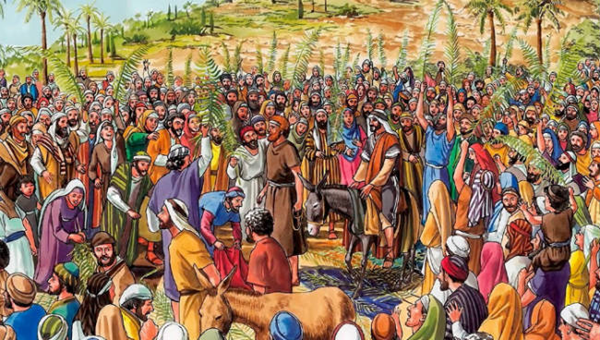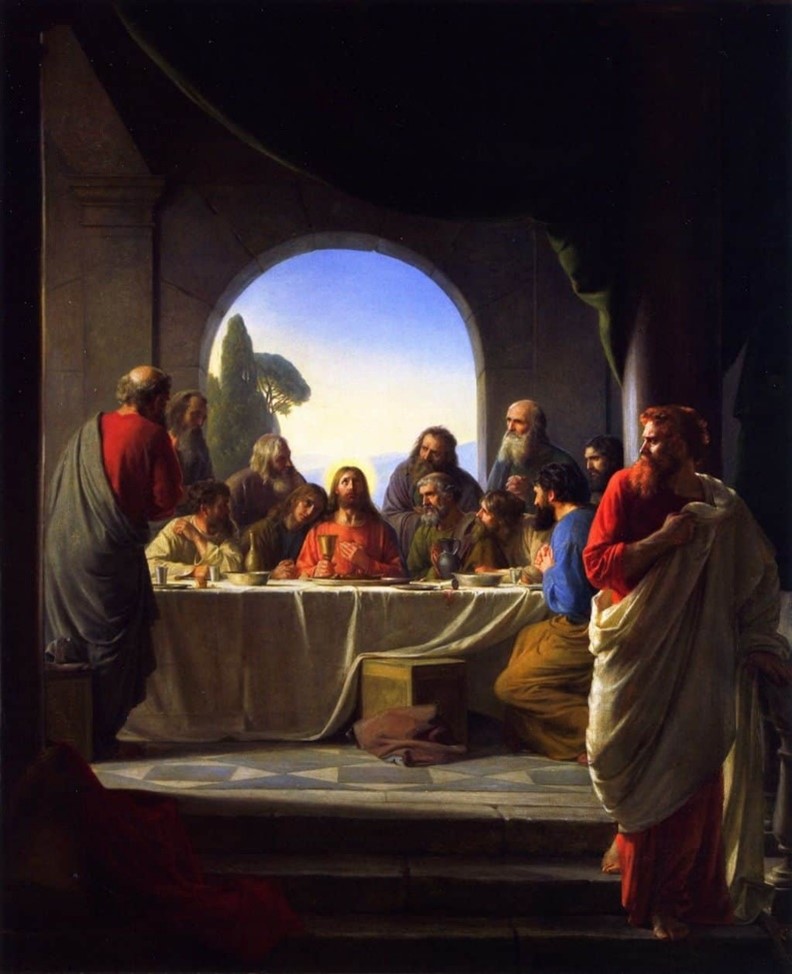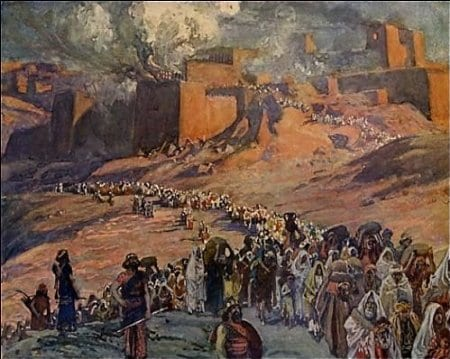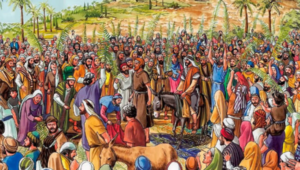Introduction
In chapter nine of his book, Daniel foretells a number of events.[1] One of these is the exact date, precise to the day, when ‘Messiah the Prince’ shall come. The point in Jesus’ ministry when He presented Himself as the Messiah was when He accepted the worship of the people as He entered Jerusalem, four days before He was crucified. This occasion was foretold by Zechariah[2] and has become known as ‘Palm Sunday.’
The date if Jesus’ triumphyl entry into Jerusalm
Image credit: Good News Productions International and College Press Publishing/ FreeBibleimages.org/ CC BY-NC-ND 4.0
So what day was this in relation to our calendar? Much has been written regarding the time of Christ’s crucifixion and resurrection. What is presented below is a view which is supported by historical data and harmonises Daniel’s prophecy with Christ as the Passover Lamb.
The time of this event can be calculated by working back from the time of Christ’s crucifixion, for which more information has been given. Although many dates have been proposed, April 3, AD 33, is consistent with the information available and is the one favored by most scholars.
The reasons they give for this date are as follows: all gospels agree that Jesus died on the day before the Sabbath. Some scholars claim there may have been two Sabbaths in that week because the first day of the Feast of Unleavened Bread is a Sabbath and that Christ may have been crucified on a day other than Friday. However, there can be no doubt that Jesus rose on the first day of the week, a Sunday, and that it was the third day, inclusive, since His crucifixion. The third Bishop of Antioch, Ignatius, writing in the first century to the Trallians, makes clear that Christ was crucified on the day of Preparation (Friday), was in the ground during the Sabbath (Saturday) and rose on the Lord’s Day (Sunday).[3] By the time of Tertullian (AD 160–220), the Greek word ‘paraskeue,’ was used in the gospels as the day of Christ’s crucifixion and it was used to denote Friday.
This fixed the crucifixion date as Nisan 14 (post-Exilic name; formerly Abib, Exodus 13:4, approximately our March/April), with Passover commencing at moonrise that evening which signaled the start of a new day; Nisan 15. There appears to be a discrepancy in the gospels with Matthew, Mark and Luke stating that Jesus ate the Passover meal[4] and John stating that Jesus,  knowing that Judas was about to betray Him, told him to leave the table and do what he had intended. Since Judas kept the money, some of the disciples thought that Jesus had sent him to buy what was needed for the feast, that is, the Passover.[5] Whether it was the Passover or the Last Supper Jesus celebrated with His disciples is the subject of another post.
knowing that Judas was about to betray Him, told him to leave the table and do what he had intended. Since Judas kept the money, some of the disciples thought that Jesus had sent him to buy what was needed for the feast, that is, the Passover.[5] Whether it was the Passover or the Last Supper Jesus celebrated with His disciples is the subject of another post.
The crucifixion took place under the administration of Pontius Pilate, who held the position from AD 26–36. The only years that Nisan 14 occurred on a Friday during that period are the years 27, 33, 36 and maybe 30. Luke states that John the Baptist commenced his ministry in the fifteenth year of the reign of Tiberius,[6] thereby dating John’s appearance to AD 29. Also, the Passover was celebrated on the first full moon of the spring. Only the dates of April 7, AD 30 and April 3, AD 33 satisfy these criteria for the time of Christ’s crucifixion. Since John records three separate Passovers during Jesus’ ministry,[7] the early date of AD 30 must be excluded, thereby leaving April 3, AD 33 as the time of Christ’s crucifixion.[8]
The problem with this date
However, there has been a problem with this later date—namely, Herod the Great was alive when Jesus was born. This is referenced by the fact that following a visit from the Maji, he ordered all babies under the age of two to be killed.[9] This implies that Jesus must have been born during the years of 6 or 5 BC, because the commonly accepted date for Herod’s death is 4 BC. And Luke states that:
Jesus Himself began His ministry at about thirty years of age.[10]
This would be in keeping with what was required for a Levitical Priest.[11] Since Jesus’ ministry lasted about three-and-a-half years, He could not have been born in 6–5 BC, commenced His ministry at the age of 30, ministered for three-and-one-half years and have been crucified as late as AD 33.
The evidence for believing Herod died in 4 BC mainly comes from the writings of Josephus (AD 37–103), a first century Jewish historian. However, Josephus was not always accurate or consistent and his chronologies should always be cross-checked.[12] Josephus states that Herod commenced his reign in 37 BC and that he reigned 34 years; elsewhere he states that Herod reigned 37 years[13] and that there was a lunar eclipse[14] (a lunar eclipse is shown) just before he died. Tradition has this event assigned to the eclipse of March 13, 4 BC. Further evidence for the 4 BC date of Herod’s death comes from coins of the period, which show that his successors began their reign in 4–3 BC.
just before he died. Tradition has this event assigned to the eclipse of March 13, 4 BC. Further evidence for the 4 BC date of Herod’s death comes from coins of the period, which show that his successors began their reign in 4–3 BC.
However, the argument of 4 BC for Herod’s death is not as strong as it seems. Four lunar eclipses occurred in this time frame: September 15, 5 B.C., March 12–13, 4 B.C., January 10, 1 B.C. and December 29, 1 B.C. John P Pratt, in a well-researched and referenced paper,[15] discusses the many problems associated with 4 BC eclipse, which was only a partial eclipse and claims the year of AD 1 to be much more in keeping with historical records and astronomical observations. Josephus, who wrote almost 100 years after the event, mentions only one lunar eclipse. Furthermore, the eclipse of 4 BC happened in the middle of the night and would not have been observed by many. In contrast, the eclipse of December 29, 1 BC was clearly visible at sunset. Also, Pratt proposes that Herod’s successors antedated their reigns, presumably extending their lengths. This, Pratt suggests, is a factor of which Josephus was not aware.
Andrew Steinmann, Distinguished Professor of Theology and Hebrew, supports the later eclipse for Herod’s death and provides supporting evidence for Herod’s sons pre-dating their reigns.[16] Vladimir Blaha using a re-work of Josephus’ work argues for December 25, 1 BC as the date of Jesus’ birth.[17] John A. Cramer Professor of Physics Oglethorpe University Atlanta, Georgia, provides a strong argument for later date for Herod’s death as well.[18]
The later date for Herod’s death means that the sixth century scholar Dionysius Exiguus, who set the Christian era of AD (Anno Domini; ‘In the year of the Lord’) and who had access to more records than are available today, was correct after all in calculating from 1 BC. The Dionysius Exiguus dating system is used to number the years of both the Gregorian and Julian Calendars (note, AD 1 follows 1 BC; there was no zero year).
Therefore, if Jesus was crucified on April 3, AD 33, then his triumphant entry into Jerusalem would have taken place on March 30[19] of that year, which was five days before the Passover[20] if we count both Nisan 10 and 14 as was the Jewish practice of counting part of a day as one day.[21] The day, being a Monday, has become incorrectly known as ‘Palm Sunday’. In complete harmony with the events of the Passover that require the lambs to be selected on Nisan 10, and then slaughtered four days (five Jewish days) later on Nisan 14 between the hours of 12 noon and 3 pm, Christ presented Himself as Messiah, the Passover Lamb[22] on Nisan 10 (Monday March 30, AD 33) and was slaughtered (crucified) on Nisan 14 (Friday, April 3, AD 33). He then died at 3 pm.
Daniel’s prayer and its answer
 Before Daniel’s prophecy is examined, it is of value to go back in time to when Jeremiah was warning Judah of their impending exile and that it would be Nebuchadnezzar, king of Babylon, who would bring this about.[23] In the same chapter,[24] Jeremiah goes on to say that they will serve the king of Babylon 70 years and he later repeats this warning with the added information that He, the Lord, will bring them back to this place after 70 years.[25] Although Jeremiah was severely criticised and thrown in a pit for his prophecy, he lived to see the first part of its fulfillment. At the time, Daniel would have been in his very early teens as he was taken to Babylon with the first wave of captives in 605 BC.
Before Daniel’s prophecy is examined, it is of value to go back in time to when Jeremiah was warning Judah of their impending exile and that it would be Nebuchadnezzar, king of Babylon, who would bring this about.[23] In the same chapter,[24] Jeremiah goes on to say that they will serve the king of Babylon 70 years and he later repeats this warning with the added information that He, the Lord, will bring them back to this place after 70 years.[25] Although Jeremiah was severely criticised and thrown in a pit for his prophecy, he lived to see the first part of its fulfillment. At the time, Daniel would have been in his very early teens as he was taken to Babylon with the first wave of captives in 605 BC.
Image credit: The accompanying painting is by James Tissot, The Flight of the Prisoners.
If we fast-forward about 69 years, Daniel is no longer a captive but a government official. Nebuchadnezzar has had a period of mental illness, thinking he was an ox and eating grass. He then recovered, gave praises to God, died and was followed by a succession of kings who only reigned for a short period before being assassinated. Finally, Belshazzar comes to the throne, mocks God, Daniel reads the writing on the wall and it’s all over for Belshazzar. The Medes and the Persians are the world-power. Daniel writes in verse 1 of chapter 9 that Darius is in his first year as king, and at this time he reads from the prophet Jeremiah that the time of exile will be 70 years, and that this time is almost up. But God said through His prophet that He would bring them back when the people seek Him with all their hearts. So, what does Daniel do? Verse 3 tells us:
Then I set my face toward the Lord God to make request by prayer and supplications, with fasting, sackcloth, and ashes.
Daniel prays from verse 3 to verse 19 and his answer comes in verse 20 when he is visited by the angel Gabriel, who tells him in a vision what is going to happen to his people.
Verse 24: Seventy weeks are determined for your people and for your holy city, to finish the transgression, to make an end of sins, to make reconciliation for iniquity, to bring in everlasting righteousness, to seal up vision and prophecy and to anoint the Most Holy.
Verse 25: Therefore and understand, that from the going forth of the command to restore and build Jerusalem until Messiah the Prince, there shall be seven weeks and sixty-two weeks; the street shall be built again, and the wall, even in troublesome times.
Verse 26: And after the sixty-two weeks Messiah shall be cut off, but not for Himself; and the people of the prince who is to come shall destroy the city and the sanctuary. The end of it shall be with a flood and till the end of the war desolations are determined.
Verse 27: Then he shall confirm a covenant with many for one week; but in the middle of the week He shall bring an end to sacrifice and offering. And on the wing of abominations shall be one who makes desolate, even until the consummation, which is determined, is poured out on the desolate.
The prophecy is contained in verse 24 and detailed in verses 25–27. The Hebrew word for ‘week’ means a period of seven; it can be seven days, seven weeks, seven months or seven years. There are four good reasons for believing the period, in this context, refers to years:
- Daniel is talking about years in verses 1 and 2.
- It is impossible to fit the events of verses 24 to 27 into days, weeks or months.
- The only other place Daniel uses the word week where he does not mean years, he qualifies it by adding the word days (10:2–3).
- The fact that verse 27 speaks of a covenant being broken at the halfway point of the seventieth seven agrees well with Daniel 7:25, 12:7 and Revelation 12:14.
Using ‘year’ for the word ‘week’, verse 24 tells us that six events are going to happen in 490 years and verses 25–27 state that these 70 lots of 7 years are in three parts: one of 7 x 7 years; one of 62 x 7 years and one 1 x 7 years. The six events are:
- To finish the transgression.
- To make an end of sins.
- To make reconciliation for iniquity.
- To bring in everlasting righteousness.
- To seal up the vision and prophecy.
- To anoint the Most Holy.
Therefore, after 70 weeks God will have dealt with sin and brought in a period of everlasting righteousness.
Verse 25 reveals when the Messiah will come. This is in two lots of time; one of seven weeks, followed by sixty two weeks, making a total of 69 weeks. This gives a total of 483 years.
The number of days in the Jewish year was 360. That is, twelve months of thirty days. This 360-day year is confirmed in Genesis chapter seven, where it states that the flood lasted 5 months; verse 11 states that it commenced on the 17th day of the second month and chapter 8, verse 4, says it finished on the 17th day of the seventh month, a total of exactly 5 months. And verse 24 of chapter seven states it lasted 150 days. Five months of thirty days equals 150 days. And again, in Revelation 12:6, we read that the woman (Israel) will seek refuge for 1,260 days, with verse 14 stating it will last three-and-one-half years.
Again, 360 days per year for three-and-one-half years equals 1,260 days. Therefore, multiplying 483 years by the number of days in each year, we obtain a total of 173,880 days.
The time of the commencement of the 70 weeks of Daniel’s prophecy is ‘from the going forth of the commandment to restore and to build Jerusalem.’ Four decrees are mentioned in scripture concerning the return of the people to Jerusalem. These are:
- The decree of Cyrus in 539 BC[26]
- The decree of Darius 1 in 519/518 BC[27]
- The decree of Artaxerxes1 to Ezra in 457 BC[28]
- The decree of Artaxerxes1 to Nehemiah in 444 BC[29]
Only the last decree could fulfill the statement, since it was the only one of the four concerned specifically with rebuilding the city. This decree was given in the twentieth year of Artaxerxes in the month of Nisan,[30] but exactly what day and year has been the source of discussion. Sir Robert Anderson (1841–1918) appears to have been the first person to have published a serious and scholarly analysis of this time in particular and Daniel’s prophecy in general with his book The Coming Prince.[31] Anderson posited the 483-year countdown commencing March 14, 445 BC (Nisan 1, 445 BC) and culminating with Christ’s triumphant entry into Jerusalem on April 6, AD 32 (Nisan 10, AD 32). Anderson’s date for the crucifixion of AD 32 is untenable, for it would mean Christ was executed on either a Sunday or Monday. Even though other errors have been found as well, Anderson did show the likelihood of the extreme accuracy of Daniel’s prophecy and set the stage for others to refine his work.
One such man was Dr Harold Hoehner, Chairman of the New Testament Department at Dallas Theological Seminary, USA. In his book Chronological Aspects of the Life of Christ,[32] he builds on the foundation that Anderson laid and corrects some of his errors. For example, it is clear that Nehemiah uses the Jewish Trishri-to-Trishri (March to April) calendar, because he records[33] that he heard of Jerusalem’s desolation in the Jewish month of Chislev (November/ December), which by the Julian calendar was the year 445 BC.[34] Later, he reports that permission was granted to restore the city.[35] This was in the Jewish month of Nisan (March/April), still in Artaxerxes’ twentieth year, but the Gregorian calendar had clicked over to 444 BC. Nehemiah states that the decree was given in the month of Nisan. Since he does not include the day of the month, it is assumed that it is the first day. That first day of the month is signified by the first appearance of the new moon. The first occurrence of crescent visibility would have appeared at 10 pm, March 4, late enough to be missed. However, on March 5, 444 BC it would have been clearly visible to all.
To summarise, Daniel’s prophecy states that Messiah the Prince shall come 173,880 days from the decree to rebuild Jerusalem. We have shown that this decree was given on March 5, 444 BC. Jesus, Messiah the Prince, entered Jerusalem on March 30, AD 33.
To find the number of days between March 5, 444 BC and March 30, AD 33, it is necessary to take the number of years between these dates (444 +33 = 477) and subtract 1 year, since only one year elapsed from 1 BC to AD 1, which gives a total of 476 years. To find the number of days in the Gregorian calendar, which is in use now, it is necessary to multiply 476 years by 365.2422 (number of Gregorian days in a year). The product of this, to the nearest day, is 173,855; this is the number of days from March 5, 444 BC to March 5, AD 33. An additional 25 days is added, bringing the number of days to March 30, AD 33. This gives exactly 173,880 days, which reveals the extreme accuracy of Daniel’s prophecy and the reliability of scripture.
After the completion of the sixty-nine weeks and before the commencement of the seventieth week, two events were predicted to take place in the following order:
- The “cutting off” of the Messiah.
- The destruction of the city and the temple.
In line with Daniel’s prophecy, Christ was crucified before the Roman general Titus destroyed the temple and the city in AD 70. The prophecy of Daniel 9:27 concerning the seventieth week and the six eve
[1] Daniel 9:24–27.
[2] Zechariah 9:9.
[3] For a thorough analysis of the days of Christ’s crucifixion and resurrection, the reader is directed to bible.ca/d-3-days-and-3-nights.htm.
[4] Matthew 26:17-29; Mark 14:12-25; Luke 22:7-20.
[5] John 13: 1–29.
[6] Luke 3:1–2.
[7] John 2:23, 6:4, 13:1.
[8] C. J. Humphreys and G. Waddington, The American Scientific Affiliation, 1985, 37, pages 2–10; H. W. Hoehner, Chronological Aspects of the Life of Christ, Zondervan: Grand Rapids, 1977.
[9] Matthew 2:16.
[10] Luke 3:23.
[11] Numbers 4:3.
[12] M. Broshi, The Credibility of Josephus, Journal of Jewish Studies 33, Spring/Autum, 1982.
[13] J. P. Pratt, The Planetarium, 1990, 19 (4), pages 8–14.
[14] A lunar eclipse occurs when the moon passes through the shadow of the earth. A full eclipse takes 2 hours.
[15] Ibid.
[16] Andrew Steinmann, From Abraham to Paul: A Biblical Chronology (St. Louis: Concordia, 2011), pp. 235–238; see also his article When Did Herod the Great Reign? Novum Testamentum 51 (2009), pp. 1–29. Referenced in: https://www.biblicalarchaeology.org/daily/people-cultures-in-the-bible/jesus-historical-jesus/herods-death-jesus-birth-and-a-lunar-eclipse.
[18] See the debate about the time of Herod’s death in Biblical Archaeology Review: https://www.biblicalarchaeology.org/daily/people-cultures-in-the-bible/jesus-historical-jesus/herods-death-jesus-birth-and-a-lunar-eclipse.
[19] In the year AD 33, Nisan 10 falls on Monday, March 30. cgsf.org/dbeattie/calendar/?roman=33.
[20] John 12:1-12.
[21] Colin J Humpreys, The Mystery of the Last Supper, Cambridge University Press, 2011, page 23.
[22] 1 Corinthians 5:7; John 1:29; 1 Peter 1:17.
[23] Jeremiah 25:9.
[24] Jeremiah 25:11.
[25] Jeremiah 29:10.
[26] 2 Chronicles 36:22, 23; Ezra 1:1–4.
[27] Ezra 6:1, 6–12.
[28] Ezra 7:11–26.
[29] Nehemiah 2:1–8.
[30] Nehemiah 2:1.
[31] Available in many reprinted editions.
[32] H. W. Hoehner, Chronological Aspects of the Life of Christ, Zondervan: Grand Rapids, 1977.
[33] Nehemiah 1:1.
[34] S. H. Horn and L. H. Wood, The Fifth Century Jewish Calendar at Elephantine, Journal of Near Eastern Studies, XIII, January 1954, page 9; R. A. Parker and W. H. Dubberstein, Babylonian Chronology 626 BC –AD 75, Second Edition, Providence, 1956, page 32; H. H. Goldstein, New and Full Moons, 1001 BC to AD 1651, Philadelphia, 1973, page 47.
[35] Nehemiah 2:1.
